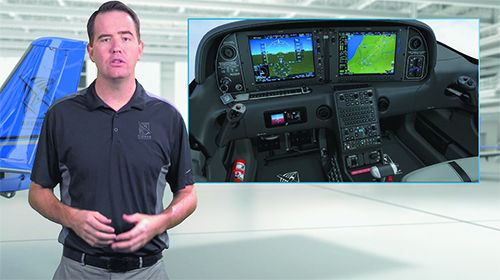I’ll admit it. If Cirrus’ Cliff Allen wasn’t sitting shotgun and backstopping my every move on a trip in a new SR22T with Garmin’s Perspective+ G1000 avionics, I’d still be on the ground fumbling with entering the flight plan in the system’s FMS. “Mastering the Garmin Perspective avionics in later SR20/22 models won’t happen in a five-hour checkout,” Allen warns. He’s right. Consider that Cirrus corporate pilots—no matter the ratings or flight experience—are restricted to 500 feet above published minimums on approaches under IFR for the first 100 hours in type. If that doesn’t speak volumes for the level of automation and complexity in these airplanes I don’t know what does.
For Cirrus, it’s all about the training, and it has plenty of good materials. For starters, the Interactive Flight Operations Manual (iFOM) is an iBook summary of how Cirrus prescribes operating the aircraft. Additionally, an integral part of transitioning to a Cirrus with a G1000 Perspective series includes the Cirrus Approach study modules. Cirrus Approach covers nearly all aspects of operating the airplane and is a library of Vimeo-based video presentations led by Anthony Bottini, a Cirrus Standardized Instructor Pilot. Among the other aircraft systems covered, there are two in-depth avionics courses.
The launching point for a Cirrus Perspective+ transition (the current G1000 in Cirrus SR20/22 models) is the SR2X Perspective+ Transition avionics training course. Bundled with the Perspective and Perspective+ Avionics, Takeoff and Landing and Engine Management courses, the Perspective Transition course in instructor led, and is really intended for non-instrument rated pilots new to flying a Cirrus. The estimated lesson time is 3.5 hours, and it took me a bit longer because I made particular note of areas that trick me up when I fly the airplane. The Perspective+ Transition course summarizes everything from cockpit layout and remote sensors to flying the system in the real world. It’s incredibly detailed and taught in plain language, with excellent supporting B-roll and graphics.
The other procedure-focused program is the Perspective and Perspective+ Avionics Course. Its fundamental goal is to present transitioning pilots the proper procedures to build their overall knowledge and confidence to fly with the Garmin system under VFR or IFR. The typical completion time is around three hours
There is a long list of items covered, broken down into video segments. It starts with the components that make up the system, the PFD, MFD, FMS, AFCS (autopilot), audio system, standby instruments, database updates, Flight Stream 510 wireless cockpit system, plus normal operations and abnormalities and reversions.
“We can’t teach pilots everything about transitioning to the Perspective and Perspective+ avionics, but we ensure they have a solid pathway to walk away from the flight training confident enough to get the airplane home, and then learn more,” said Brad DeGusseme, the company’s Learning Content Manager. The avionics courses are $200 each, and are included in a new Cirrus purchase.





